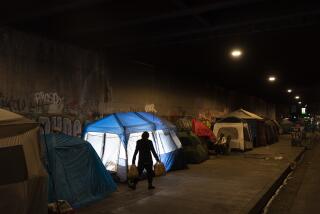Women and Children Last : NEXT TIME SHE’LL BE DEAD: Battering and How to Stop It, <i> By Ann Jones (Beacon Press: $22; 288 pp.)</i>
- Share via
Count to 12. Another woman has just been beaten by her spouse or lover or ex.
Ann Jones, author previously of “Women Who Kill,” doesn’t like the term domestic violence. In her new book, “Next Time She’ll Be Dead: Battering and How to Stop It,” she describes it as “one of those gray phrases, beloved of bureaucracy, designed to give people a way of talking about a topic with out seeing what’s really going on.” What atrocities have been obfuscated by the euphemism domestic violence ? Here are a few: assault, battery, rape, kidnaping, captivity. Torture and murder.
These offenses (except perhaps for rape), if committed on the streets by one man against another, or by a stranger upon a woman or child, in all likelihood would be vigorously prosecuted. But traditionally, a man’s home is his castle, and what he does to his wife and children in the privacy of his own home is his own business. “Written by men for men,” Jones tells us, “the law is designed to protect men from the power of the state and adjudicate conflicts between men, to preserve order in a society of men.” Women and children first? Not when it comes to the right to live free from bodily harm.
In media reports, should a case be so gruesome as to merit the attention of the Fourth Estate, women “experience battering. They suffer abuse. They undergo assault. Rarely in the authoritative literature does a man hit a woman: in the gut, for instance, or the face, with his fist, hard--hard enough to split her lip, loosen her teeth, break her nose, lace her eyeball with a red web of ruptured veins--hard enough to make the blood run down the page. In real life it happens all the time.” The language of the reports themselves places blame for the attack on the victim, refusing even to acknowledge that there must have been someone on the scene to do the hitting, kicking, punching, spitting.
The “passive voice of the journalists” is but a reflection of another kind of passivity. The police stand idly by, often refusing to arrest when a man beats his wife or ex-wife, his girlfriend or ex-girlfriend. Even in localities that compel police officers to do so by enacting mandatory arrest laws, there are cops who will face disciplinary action rather than arrest a man who is beating up his wife. This sudden and highly unusual passivity on the part of the police is often reinforced by the courts, who will tell the bruised and battered woman standing before the bench asking for a restraining order to go home and try to work things out.
Some judges just don’t like the idea of breaking up a family, even when husband is breaking his wife’s bones. Jones tells us that “ . . . more than half the women assaulted are injured, and at least 25% of them seek medical treatment. Ten percent of the injured visit hospital emergency rooms and many others visit private physicians to have their wounds dressed, their broken bones set, their injuries treated. . . . Of women requiring emergency surgery, one in five was battered, according to one study; one in two, according to another. Battering accounts for half of all cases of alcoholism in women. It accounts for half of all rapes of women over the age 30. . . . Battering is a cause of one-quarter of suicide attempts by all women, and one-half of suicide attempts by black women. And the Journal of the American Medical Assn. reports: ‘Approximately 37% of obstetric patients, across class, race and educational lines, are physically abused while pregnant.’ Among the results: ‘placental separation, antepartum hemorrhage, fetal fractures, rupture of the uterus, liver, or spleen, and pre-term labor.’ Pre-term labor, of course, may mean spontaneous abortion or miscarriage.”
The carnage Jones documents in “Next Time She’ll Be Dead,” and the lack of concern, not to mention assistance, on the part of those institutions that are supposedly in place to help battered women, are enough to make us lose hope. We learn that from 1967 to 1973, “battering men killed 17,500 women and children in the United States. To grasp the enormity of that figure consider that only a little more than twice as many men--39,000 to be exact--were killed during the same period in combat in Vietnam. Thankfully the war in Vietnam ended, but the count of women injured and killed by men on the home front continues. In 1991 more than 21,000 domestic assaults, rapes, and murders were reported to the police every week.”
But this is not simply a book of horrifying statistics. Jones introduces herself to us as the victim of an abusive, battering father. “My father was a drunk,” she says, “a wife beater, and a child abuser. That’s never the whole story of course, so he was also other things: a modestly successful businessman, a civic leader, a war hero, an athlete, a prize-winning angler, a churchgoer, a tenor, a patriot, a Republican, a baseball fan, a formidable player of gin rummy. And more important, a delightful and funny man. Of all my family, all now long gone, it’s my father I miss.”
Though her righteous anger at the “simplistic, regimented, confrontational, adversarial, and overly technical--in a word, macho” nature of the law and at those who only pretend to enforce it is present in every sentence, Jones does not seem to be writing for vengeance or out of any man-hating impulse. What she deplores is something many men also abhor: male violence against women and children, and the inertia that has infected each and every institution that could possibly do something to reduce that violence.
Assumptions about the “typical” battered woman are many, fed to us by psychologists and sociologists trying to prove their theories or make quick money on a self-help book, and almost always wrong. All battered women are not passive. Most make multiple attempts to escape the men who are beating them; they continue to try to get away until they succeed or are killed by the men who “love” them to death. Jones draws an important distinction between passivity and powerlessness. “Powerlessness is a political condition, while passivity is a strategy adopted by the powerless to survive.” Not all battered women lack jobs or education: Battering cuts a swath across socioeconomic lines. The sole characteristic battered women share is that they are women.
And what of the batterers? Are they, as they and many psychologists claim, victims of their own lack of control? Willing, but unable to stop themselves? Jones tells us “it’s vital to understand that battering is not a series of isolated blow-ups. It is a process of deliberate intimidation intended to coerce the victim to do the will of the victimizer. The batterer is not just losing his temper, not just suffering from stress, not just manifesting ‘insecurity.’ . . . These are excuses for the violence. . . . Batterers can be perfectly agreeable, straightforward, or conciliatory to police officers, bosses, neighbors, co-workers, or friends when they think it’s in their best interests. . . . No, the violent man is not out of control. He is a man at work on his own agenda, which is to train ‘his’ woman to be what he wants her to be, and only what he wants her to be, all the time.”
If there is no set of psychological characteristics which predestines a woman to a life of being battered, and no set from which the “experts” might properly determine which boys will grow up to be batterers, what are we to make of all the male violence being heaped on women? Jones asks, “Could it be that battered women have some function, some role or social utility we haven’t taken into account? . . . What are battered women for?” Battered women, she concludes, “are to sexism what the poor are to capitalism--always with us. They are a source of cheap labor and sexual service to those with the power to buy and control them, a ‘problem’ for the righteous to lament, a topic to provide employment for academic researchers, a sponge to soak up the surplus violence of men, a conduit to carry off the political energy of other women who must care for them, an exemplum of what awaits all women who don’t behave as prescribed, and a pariah group to amplify by contrast our good opinion of ourselves. And for all their social utility, they remain largely, and conveniently, invisible.”
There are suggestions, in the final chapter, for reducing or even, ideally, ending the violence, for doing away with battered women not by ignoring their plight until the men who love them shoot them or stab them or bludgeon them to death, but by making changes in policy and in judgment that include new legislation, education of health care professionals, clergy, and teachers, and money for the shelter network. Print and broadcast journalists should lose the “sexist cliches,” stop talking about the spurned lovers, fits of rage and despair. Look at it objectively. A man beat a woman. That’s assault and battery. Arrest him and prosecute him and hope the court gives him jail time.
Take a look at our priorities. The Federal Bureau of Prisons admits that 95% of its prisoners are nonviolent. Get them into alternative punishment programs and make room for the men who are beating, maiming and killing women. Another good way to free up prison cells to make room for the violent would be to release the thousands of women who are currently locked up because the police and the courts and the doctors and the clergy left them, alone and terrified, to defend themselves against men who were trying to kill them.
More to Read
Sign up for our Book Club newsletter
Get the latest news, events and more from the Los Angeles Times Book Club, and help us get L.A. reading and talking.
You may occasionally receive promotional content from the Los Angeles Times.







